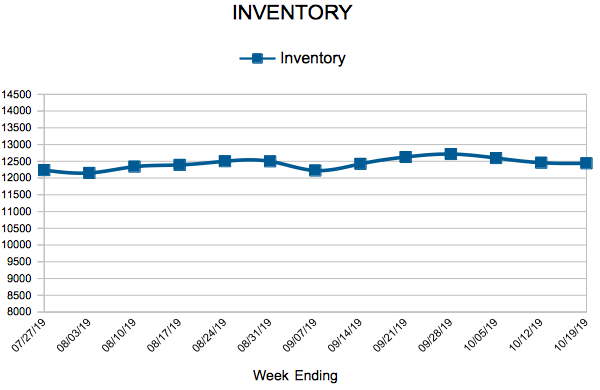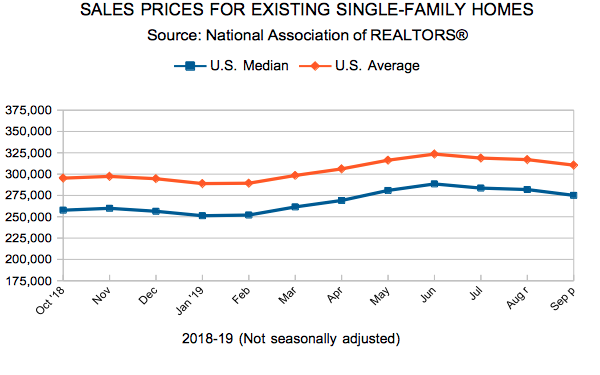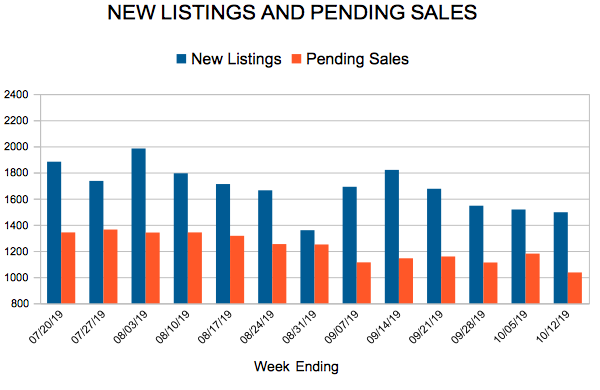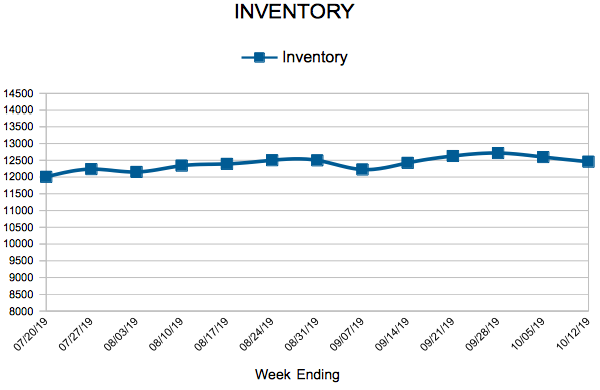- « Previous Page
- 1
- …
- 120
- 121
- 122
- 123
- 124
- …
- 234
- Next Page »
Weekly Market Report
 For Week Ending October 19, 2019
For Week Ending October 19, 2019
While the U.S. Commerce Department reported that total housing starts dropped 9.4% month over month in September, that drop was focused on the apartment and condo segment while single-family housing starts actually rose .3%. Throughout much of the country, the continued low level of housing inventory is constraining sales activity from where it would be in a balanced market. Active inventory is in its normal seasonal decline, leaving buyers with fewer choices as we move towards the end of the year.
In the Twin Cities region, for the week ending October 19:
- New Listings decreased 6.1% to 1,309
- Pending Sales increased 6.5% to 1,138
- Inventory decreased 3.7% to 12,440
For the month of September:
- Median Sales Price increased 6.6% to $279,250
- Days on Market increased 2.4% to 43
- Percent of Original List Price Received increased 0.1% to 98.5%
- Months Supply of Homes For Sale decreased 3.7% to 2.6
All comparisons are to 2018
Click here for the full Weekly Market Activity Report. From MAAR Market Data News.
Mortgage Rates Rise
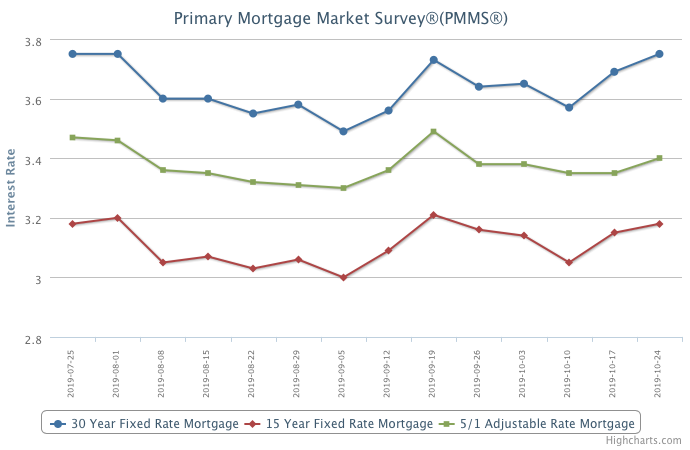
October 24, 2019
The outlook for a favorable resolution to the trade dispute between the U.S. and China is still unclear, introducing some volatility into financial markets and the benchmark 10-year Treasury yield. Mortgage rates are following suit but are at near historic lows, while mortgage applications to purchase a home remain higher year over year.
Information provided by Freddie Mac.
Existing Home Sales
September Monthly Skinny Video
“Nationally, buyer and seller activity remained strong, buoyed by low mortgage rates.”
New Listings and Pending Sales
Inventory
Weekly Market Report
 For Week Ending October 12, 2019
For Week Ending October 12, 2019
In the last month, mortgage rates have fallen to their lowest monthly average in more than three years, and now Fannie Mae is predicting that continued low rates, and possibly lower rates, are expected in 2020. These historically low mortgage rates have and will continue to support buyer demand and may create additional lift to home prices as lower financing costs give buyers the ability to offer more to secure their dream home.
In the Twin Cities region, for the week ending October 12:
- New Listings increased 7.3% to 1,496
- Pending Sales decreased 5.9% to 1,036
- Inventory decreased 4.4% to 12,457
For the month of September:
- Median Sales Price increased 6.5% to $279,000
- Days on Market increased 2.4% to 43
- Percent of Original List Price Received increased 0.1% to 98.5%
- Months Supply of Homes For Sale decreased 3.7% to 2.6
All comparisons are to 2018
Click here for the full Weekly Market Activity Report. From MAAR Market Data News.
Sales, prices still rising despite some changes this year
The latest numbers for Twin Cities residential real estate show a stable market with some ongoing signs of transition. Prices are still rising, supply is still tight, and demand has recovered even while market times have lengthened. Even though more buyers are closing on homes, the urgency has subsided somewhat. Days on market rose 2.4 percent from last September, marking the fifth year-over-year increase in the last seven months. Market times remain swift despite modest increases. Sales rose 3.4 percent and the median sales price increased 6.6 percent to $279,250. Pending sales—a measure of signed contracts and future demand—rose 2.9 percent. Both pending and closed sales are down slightly for the year so far, but that may change. New listings were up 2.5 percent, helping some buyers take advantage of historically low rates. Sellers have been accepting a slightly lower share of their list price compared to the year prior for seven of the last eight months—with September bucking that trend. This, along with other indicators, suggests the market is rebalancing in a way that could benefit buyers.
The number of active listings for sale is up over the last 12 months and for most of 2019. Even so, the market remains tight—particularly for first-time buyers and downsizers competing in the under $300,000 segment where multiple offers and homes selling for over list price remain commonplace. Despite the demand, builders struggle to replenish inventory in that undersupplied segment due to high land and material costs combined with a significant labor shortage and tricky regulations. The shortage of affordable homes has led to an increase in remodeling as people are staying in their homes longer. It’s challenging to find comparable home at a similar payment in the desired location. With just 2.5 months of supply, the Twin Cities is still significantly undersupplied.
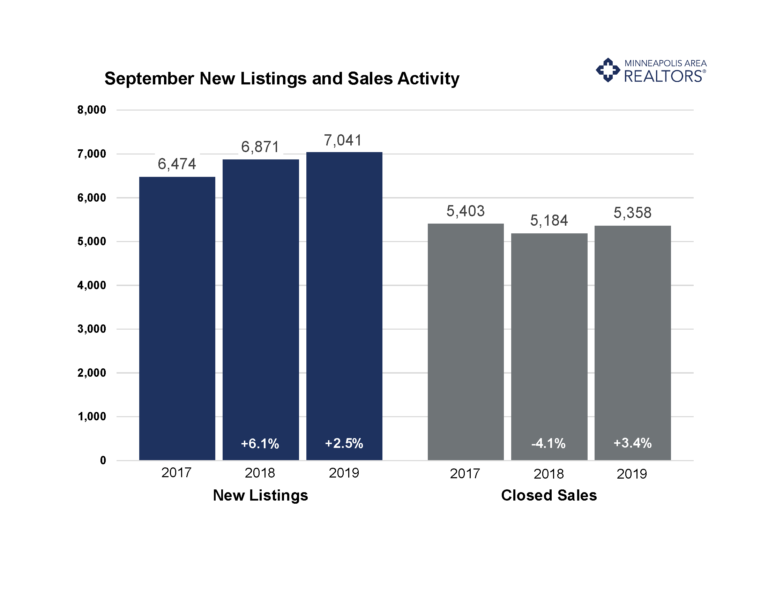
September 2019 by the Numbers (compared to a year ago)
- Sellers listed 7,041 properties on the market, a 2.5 percent increase from last September
- Buyers closed on 5,358 homes, a 3.4 percent increase
- Inventory levels decreased 5.6 percent from last September to 12,478 units
- Months Supply of Inventory was down 7.4 percent to 5 months
- The Median Sales Price rose 6.6 percent to $279,250
- Cumulative Days on Market rose 2.4 percent to 43 days, on average (median of 22)
- Changes in Sales activity varied by market segment
-
- Single family sales rose 5.5 percent; condo sales increased 1.4 percent; townhome sales fell 0.5 percent
- Traditional sales increased 4.8 percent; foreclosure sales dropped 21.1 percent; short sales fell 55.6 percent
- Previously owned sales were up 4.4 percent; new construction sales climbed 2.6 percent
Quotables
“Attractive interest rates have unleashed some of the pent-up demand from earlier this year,” said Todd Urbanski, President of Minneapolis Area REALTORS®. “But each price point, product type and area is unique.”
“Buyers are still very much motivated despite some challenges,” said Linda Rogers, President-Elect of Minneapolis Area REALTORS®. “It really shows the resilience of our region and the value of homeownership.”
From The Skinny Blog.
Mortgage Rates Jump
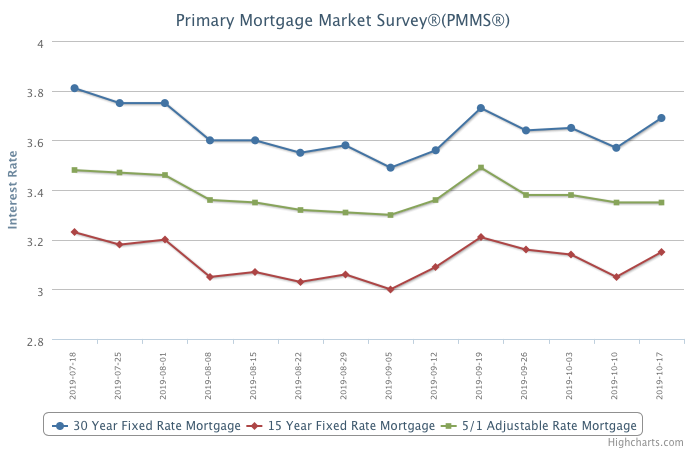
October 17, 2019
Despite this week’s uptick in mortgage rates, the housing market remains on the upswing with improvement in construction and home sales. While there has been a material weakness in manufacturing and consistent trade uncertainty, other economic trends like employment and homebuilder sentiment are encouraging.
Information provided by Freddie Mac.
- « Previous Page
- 1
- …
- 120
- 121
- 122
- 123
- 124
- …
- 234
- Next Page »
